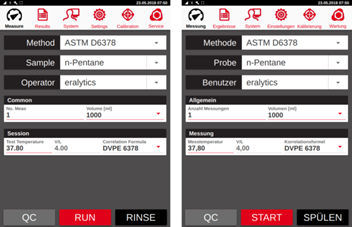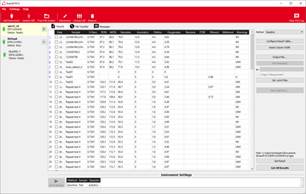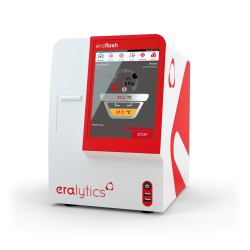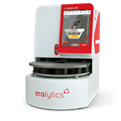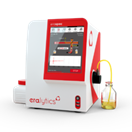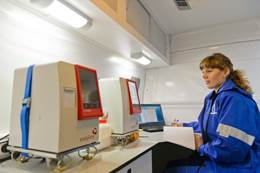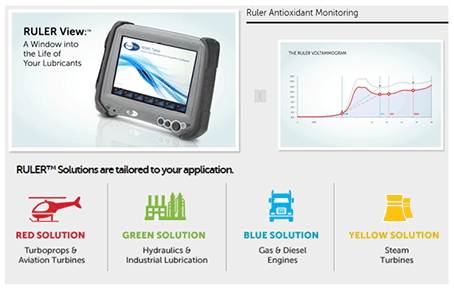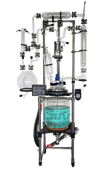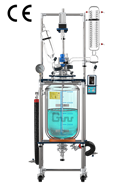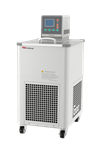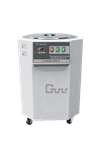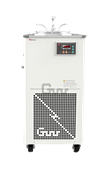
Filtertechnik Ltd. เป็นบริษัทผู้ผลิตเครื่องทดสอบ เครื่องนับจำนวนและวัดขนาดอนุภาคของน้ำมัน
(Particle Counter) เครื่องวัดระดับความสะอาดของน้ำมัน (ISO
Cleanliness Class) ตามมาตรฐาน ISO4406, SAE AS4059 &
NAS 1638 เครื่องกรองน้ำมันหล่อลื่น เครื่องศึกษาประสิทธิภาพในการกรองน้ำมัน
เครื่องประเมินอายุการใช้งานของน้ำมัน (Oil Life Condition /
Oil Condition Monitoring) การใช้งานเหมาะสำหรับการทดสอบน้ำมันหล่อลื่น (New Oil, In-Service Oil, Used Oil) น้ำมันไฮโดรลิก
น้ำมันเบรก น้ำมันสังเคราะห์ น้ำมันดีเซล น้ำมันเครื่องบิน น้ำมันเชื้อเพลิง
ตัวทำละลาย สารเคมี และของเหลวอื่น ๆ มีให้เลือกทั้งแบบทดสอบนอกสถานที่ (Portable
Particle Counter) แบบตั้งโต๊ะสำหรับห้องปฏิบัติการ (Laboratory
Particle Counter) และแบบทดสอบต่อเนื่อง (Online Particle Counter) ตัวเครื่องทดสอบแบ่งออกเป็นสองประเภทตามลักษณะของเซ็นเซอร์ที่เลือกใช้
ได้แก่ Laser Particle Counting / หลักการการบังแสงหรือดูเงาการตกกระทบของอนถภาค
และ Digital Imaging Particle Counting / หลักการวิเคราะห์ด้วยภาพดิจิตอลที่พัฒนามาเป็นพิเศษสำหรับตัวอย่างที่มีปัญหาการปนของฟองอากาศ
ทำให้ไม่สามารถวัดค่าขนาดและนับจำนวนได้ถูกต้อง นอกจากนี้มีระบบจดจำรูปร่างของอนุภาคโลหะที่เกิดจากการสึกหรอระหว่างการใช้งาน
เช่น Fatigue
Wear, Sliding Wear, Cutting Wear, Fibres เป็นต้น และสามารถต่อเข้ากับเซ็นเซอร์เพื่อวัดปริมาณความชื้นสัมพัทธ์ในหน่วย %RH (ในกรณีที่ใช้วัดน้ำมันหล่อลื่น) และค่าความชื้นในหน่วย PPM (ในกรณ๊ที่วัดน้ำมันดีเซล)

OIL CONDITION MONITORING

Particle Pal Range Comparison

Laser Particle Counters

Digital Imaging Particle Counters

Moisture Sensors
Particle Pal Range
With 25
years’ worth of expertise and innovation, our multiple award-winning Particle
Pal products are modular designs utilising a wide range of sensors to suit
individual testing requirements.
Filtertechnik offer two particle counting options: Laser Counters or Digital
Imaging, which is a more advanced particle counting technology with a wide
range of benefits (see more below).
There are currently 16 product variations, use our selection guide below to
refine your search in order to find the best Particle Pal for your application.
Particle Pal Pro: V3
Our Particle Pal Pro
range, harnesses advanced digital imaging particle
counting technology and offers a broader micron
range up to 70 microns. The powerful CMOS camera can recognise the shape of
each particle, which then categorises it into either fatigue, sliding or
cutting wear to help pinpoint root causes of system failure. Along with
ground-breaking air bubble detection/elimination, there is also the ability to
handle higher viscosities up to 2,400cSt. Digital Imaging is not affected by
oil additives. Add other sensors such as Water Sensing, Oil Life
determination and Viscosity to give incredible insight into the condition of
your oil or diesel fuel.
The Pro Range also prides
itself on an onboard asset management tool, which is pre-installed on each Pro
model as standard. The Asset tool allows users to trend, analyse and
interoperate data like never before. Learn all about it in the short video on
this page.
Particle Pal Plus: V4
The latest addition to
the family: the all-new Particle Pal Plus. The Particle Pal Plus incorporates
all the benefits of digital imaging particle counting into a compact case,
offering a low-cost alternative to Pro. Full-spectrum ISO counts, bubble
elimination plus ISO counts are not being affected by phantom
particles/oil additives, which is a known issue with laser technology.
Particle Pal Plus is
modular and can be built with an array of different sensors for a deep insight
into oil and fuel health. Two pump variations are available, a standard gear
pump that can be used on viscosities up to 320cSt or the high viscosity version
(HV) up to 2,400cSt.
Digital
Imaging Particle Counter

Particle Pal Pro - Digital Imaging Portable Particle Counter

Particle Pal Pro + Water Sensor - Digital Imaging
Portable Particle Counter

Particle Pal Plus: Digital Imaging Portable
Particle Counter

Particle Pal Plus + Water RH%: Digital Imaging
Portable Particle Counter

Particle Pal Plus + Water PPM: Digital Imaging
Portable Particle Counter

Particle Pal Plus + Water PPM and Density Sensor:
Digital Imaging Portable Particle Counter

Particle Pal Plus High Viscosity: Digital Imaging
Portable Particle Counter

Particle Pal Plus High Viscosity + Water RH%:
Digital Imaging Portable Particle Counter

Particle Pal Plus High Viscosity: Particulate,
Water RH%, Viscosity and Density

Particle Pal Pro: Life - Digital Imaging Portable
Particle Counter: Including water and remaining oil life sensor

Particle Pal Pro + Viscosity - Digital Imaging
Portable Particle Counter
Laser
Particle Counters

Particle Pal - Laser Portable Particle Counter

Particle Pal + Water & Density Sensor - Laser
Portable Particle Counter

Particle Pal: Life - Laser Portable Particle
Counter: Including water and remaining oil life sensor
Understanding Phantom Particle Counts

Filtertechnik have developed a portfolio of products for
accurate real-time monitoring of Particulate, Water Content and Remaining Life
for Oil and diesel fuels. We offer 2 particle counting approaches, new Digital
Imaging technology and more traditional Laser Particle counters.
S120 Digital Imaging Particle Counter
The S120 Digital Imaging Particle Counter is a huge step
forwards in accurate determination of oil and diesel fuel Particle counting
using revolutionary new digital imaging and advanced algorithyms to analyse
particles on the fly. A wider particulate size categorisation (4, 6, 14, 21,
38, 70 and >100 microns are counted and categorised) as well as shape
recognition sorting particles 20 microns and above into; Sliding, Cutting and
Fatigue Wear. An additional major feature is bubble recognition and
elimination from ISO counts.
Filtertechnik have conducted extensive testing of both Digital Imaging and
Laser counting when Siloxane based anti-foaming additives are present in
mineral oil, especially polydimethylsiloxane, a common additive to hydraulic
oils. This additive causes phantom
particle counts with laser counters but not
with digital imaging. For more information on this phenomenon please
click here.

Particle Pal Pro
Utilising Digital Imaging

S120 Digital Imaging
Particle Counter
Get a deeper insight into oil health
The
revolutionary new Digital Imaging particle counting technique gives
unprecedented insight into the type and quantity of contamination in any given
oil or diesel fuel sample. ISO/NAS/SAE counts as well as a broader micron
range, shape recognition, bubble elimination and the ability to handle higher
viscosities.

This
breakthrough technology uses advanced algorithms to calculate the size and
shape of particulate on images taken at between 2 & 4 frames/second. The
technology also gives root cause shape recognition to the particulate in live
systems or bottle samples of any oil. Special algorithms and AI analyse images
on the fly with a resolution of 2 microns up to several hundred microns.
High-resolution images are saved for further analysis and reporting such
as the one above.
Particles
are counted and categorised into Fatigue, Sliding or Cutting Wear. Air
Bubbles and Water Droplets are counted and then eliminated from the counts
making this suitable for live testing or permanent installation on systems
where air is present such as large gearboxes. In addition, anti-foaming
additives such as polydimethylsiloxane are not counted as particles by digital
imaging, this is a major advantage over Laser Particle counters which see's the
micelle-like formations created by this additive as contamination, these
are phantom
particles, often resulting in particle counts being raised by 2 to 3 ISO
codes, especially the 4 and 6 micron channels. Filtertechnik supply the S120
counter as a stand-alone particle counter for integration into live systems for
24/7 monitoring. Alternatively, we have developed a range of portable
oil analysis cases designed to give on the
spot oil analysis and a deep understanding of the type and quantity of
contamination in any given oil sample. Built-in software takes readings from
the new digital imaging technology and presents Engineers with an easy to
understand analysis including images of contamination in the oil sample.
MOISTURE SENSORS

RH Water monitor
sensor and display

Water Measurement
Sensor WMS500 for Genuine PPM
Filtertechnik
offer two types of water sensors for determining the quantity of water in oils,
fuels and biofuels; our RH sensors and our WMS500 PPM sensors
RH
Water Monitor: Our RH (Relative Humidity) water monitor gives the percent
saturation of a given fluid. 100% saturation is the point at which suspended
water becomes harmful free water. These sensors are lower cost and are very
useful for hydraulic applications. Outputs are scaled and 4-20mA.
WMS500
PPM Sensor: Our Genuine PPM sensors are highly
accurate parts per million (PPM) sensors and are particularly useful for transformer
oils and diesel fuels or biofuel. The sensors are calibrated to a Karl
Fischer device and fully temperature compensated.
To
understand the different relationships between %RH and PPM please see below:
Parts
per million (ppm)
:
Our
PPM sensor gives a count of the absorbed water up to the saturation point of a
given oil or fuel. Beyond the saturation point the sensor 'locks out' as free water
will have formed.
Relative
humidity:
Relative
Humidity or RH is expressed as a percentage. 100% RH equates to the maximum
amount a given oil or fuel can hold (absorbed water) before it becomes
saturated and free water forms.
To
view all our quality control and instrumentation click
here
UNDERSTANDING PHANTOM PARTICLE
COUNTS
The
increased use of siloxane based anti-foaming agents is causing issues with laser
counter technology.
IMAGINE
THIS: You have been filtering 150 litres of hydraulic fluid off-line with
staged 5 and 1 micron filter elements at a rate of 25 litres per minute (1,500
litres per hour). You have been using a laser light-blockage method (LBM),
automatic particle counter to verify the fluid cleanliness. The starting
cleanliness per ISO 4406:2017 was 25/22/15. After eight hours, the cleanliness
has only dropped to 22/20/13. You’ve checked that the filter element is not
clogged and not in bypass. You even went through the trouble of making sure
there was an element actually in the filter. How is this possible? What you’re
likely experiencing is a classic case of “phantom” particle counting.
Demystifying phantom particle counts
Phantom
particle counting is a documented problem, encountered when using laser-based
LBM particle counters to verify the cleanliness of mineral based fluids
containing certain insoluble additives. Silicone-based antifoam agents such as
polydimethylsiloxane are common additives causing problems. Fluids used in
mobile fluid power systems are typically formulated to contain high antifoam
concentrations. Research has suggested that through differential surface tension,
the silicone-based antifoam additive agents adhere to the inner wall of
microscopic, entrained air bubbles, resulting in micelle-like encapsulations of
the additive agents that then take on the apparent shape characteristics of a
water droplet. The micelle-like antifoam agent encapsulations typically range
in 4-10µm in size. Once the encapsulations rise to the fluid surface, the
agents quickly pierce the air bubble and return back into the fluid. In a
related study on the effects of a variety of nonsolid contaminants and
additives on LBM particle-counting accuracy, it was found that a base stock
mixture containing 0.02% (by weight) of a silicone antifoam agent increased the
particle count by a minimum factor of three. The erroneous particle accounts were
particularly evident in the 4µm and 6µm channels of the ISO 4406 cleanliness
standard.
Limitations of Laser particle counts
Light
blocking method (LBM) Laser particle counters are useful in many applications
and the principle of the method is fundamentally simple. Fluid flows through a
measurement cell containing a light source on one side and a receiver
(photodetector) on the opposite side. The light source becomes partially
blocked as particles pass through the measurement cell, creating a light radiation
differential (a shadow) – corresponding to the circular cross-sectional size of
the passing particles. Because of this fundamental operating principle, LBM
particle counters suffer from a key drawback: the inability to discern solid
contaminants from other contaminants such as water, air bubbles, phantom
particles, and so on. So, how can the phantom particles be overcome using
automatic particle-counting technology? There is an alternative solution.
Digital imaging particle counting
Digital imaging particle counting uses
size and shape-recognition technology, based on advanced algorithms to
distinguish contaminants. For example, a direct imaging particle counter can
distinguish contaminants into fatigue, cutting and sliding wear, as well as
fibre and air bubble categories based on shape characteristics. It can also
recognize water droplets (though water droplets are typically not recorded).
The distinction of contaminants allows for more accurate particle counting, by
negating nonsolid particles like entrained air bubbles and water droplets.
The S120 digital imaging particle counter can
recognise solid particles and summarize them into 4, 6, 14, 21, 38, 70 and
>100 micron ranges. It can also recognise shapes and give individual shape
recognition counts as sliding, cutting and fatigue wear particles. Bubbles are
also recognised and removed from the counts.
Therefore,
digital imaging particle counting technology can negate the micelle-like
antifoaming additive encapsulations as water droplets – phantom particles –
allowing users to understand the condition of their fluids with confidence.
Various real-world case studies demonstrate how the Particle Pal Pro a fluid
condition monitoring solution with digital imaging particle counting
technology, can overcome phantom particle counting.

Laser vs digital imaging particle counter test
In
a lab-based test conducted on base oil with no additives, Filtertechnik ran 2
particle counters feeding from the same oil warmed to 40°C. - a laser counter
and digital imaging particle counter. Filtertechnik then dosed in exactly
100ppm polydimethylsiloxane anti foaming additive. The results were immediately
apparent in the laser counter, affecting the 4 and 6 micron counts by up to 3
ISO codes, the 14 micron count slightly less so, but still an increase of 1 ISO
code. The digital imaging counter remained unaffected by the additive.

CASE STUDY
An
OEM of large off-highway equipment was experiencing continuous particle counter
inaccuracies at a verification stage of assembly. The rejections due to fluid
condition were mounting, causing delayed shipments and significant related
costs. The average holding time delay due to rejection was seven days, which
incurred a holding cost of £1,000-a-day per unit. At the consultation phase of
the case study, eight units had been delayed.
The
diagnosis was in: the existing laser light-blockage-type particle counters were
providing inconsistently high and erroneous particle counts. The ISO 4406
cleanliness would frequently measure 23/22/19, despite a strong
fluid-maintenance and conditioning regime. Third-party fluid analysis reports
and fluid datasheets suggested that the synthetic hydraulic fluid contained a
high concentration of a siloxane (silicone derivative) antifoaming additive,
known to cause phantom particle measurements in LBM automatic particle
counters.
Filtertechnik
provided an extensive on-site demonstration that proved the advanced digital
imaging technology of the Particle
Pal Pro portable fluid contamination monitoring solution, which
measured an average ISO fluid cleanliness of 15/14/10. This allowed the
customer to successfully process the fluid and pass six units during the first
day of demonstration. The two remaining backlogged units passed early on the
second day of demonstration. The savings evidenced by the demonstration equated
to approximately 35% in cost savings and an 81% reduction in holding time.
For
more information on the Particle Pal Pro click
here
![]()

